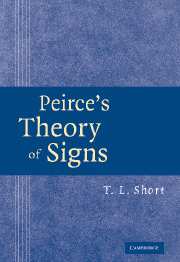Book contents
- Frontmatter
- Contents
- Preface
- Acknowledgments
- 1 Antecedents and Alternatives
- 2 The Development of Peirce's Semeiotic
- 3 Phaneroscopy
- 4 A Preface to Final Causation
- 5 Final Causation
- 6 Significance
- 7 Objects and Interpretants
- 8 A Taxonomy of Signs
- 9 More Taxa
- 10 How Symbols Grow
- 11 Semeiosis and the Mental
- 12 The Structure of Objectivity
- Bibliography
- Name Index
- Subject Index
- Frontmatter
- Contents
- Preface
- Acknowledgments
- 1 Antecedents and Alternatives
- 2 The Development of Peirce's Semeiotic
- 3 Phaneroscopy
- 4 A Preface to Final Causation
- 5 Final Causation
- 6 Significance
- 7 Objects and Interpretants
- 8 A Taxonomy of Signs
- 9 More Taxa
- 10 How Symbols Grow
- 11 Semeiosis and the Mental
- 12 The Structure of Objectivity
- Bibliography
- Name Index
- Subject Index
Summary
Peirce referred to certain types of sign – icon, index, symbol and term, proposition, argument – from early on, but he did not initiate a comprehensive semeiotic taxonomy until 1903. And he never completed it. Every formulation was tentative. Nevertheless, its main lines were clear from the start. What a sign is in itself is divided triadically, as monadic, dyadic, or triadic; so also, what a sign is in its relation to its object is divided triadically; and so also, what it is in its relation to its interpretant is thus divided. Any sign will belong to one each of each of those three triads. That yields twenty-seven combinations, though seventeen of them are ruled out on formal grounds. Thus, in 1903, ten classes of sign were recognized. That number increased when distinctions were made between immediate and dynamic objects and between immediate, dynamic, and final interpretants. In 1908, there were ten trichotomies and sixty-six classes of sign, and a potentiality for further subdivisions.
We begin with the three triadic divisions of 1903. The principles presupposed, especially that by which certain combinations are proscribed, shall be left unexamined until the next chapter. For it is the examples that motivate the principles. In the end, examples and principles are both justified, if at all, by their being shown to fit together, each with the other. In 1903, in the midst of his first efforts to form a semeiotic taxonomy, Peirce wrote:
The principles and analogies of Phenomenology enable us to describe, in a distant way, what the divisions of triadic relations must be. […]
- Type
- Chapter
- Information
- Peirce's Theory of Signs , pp. 207 - 234Publisher: Cambridge University PressPrint publication year: 2007



